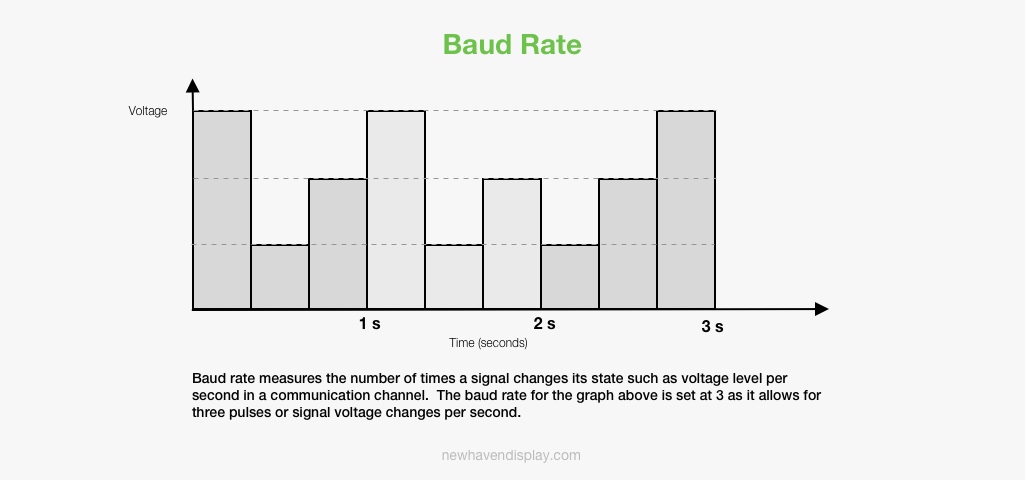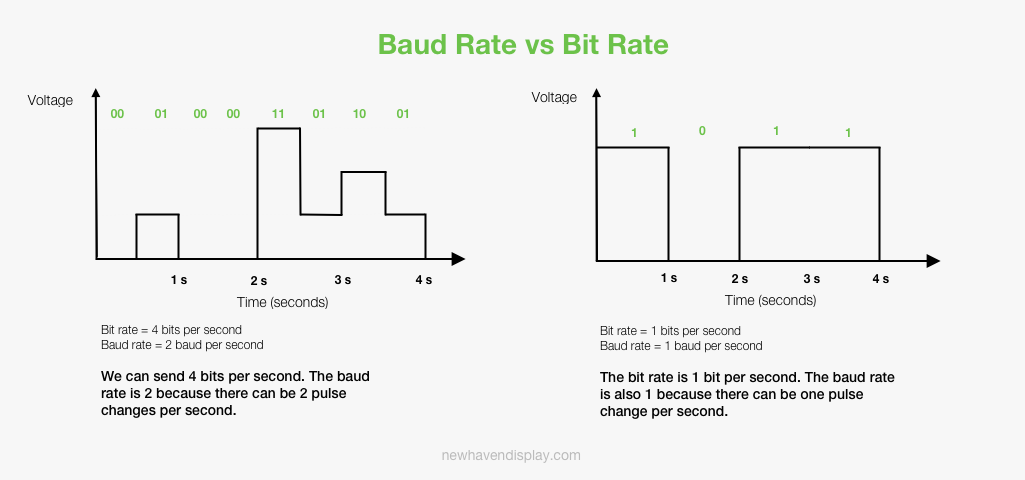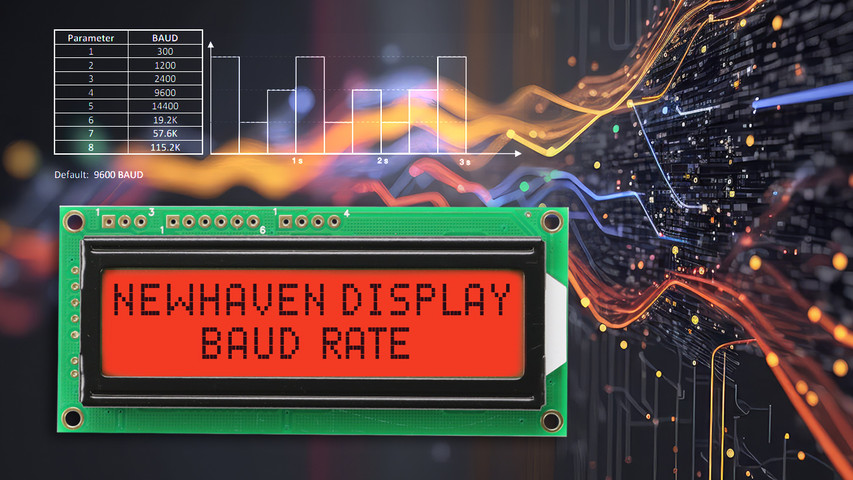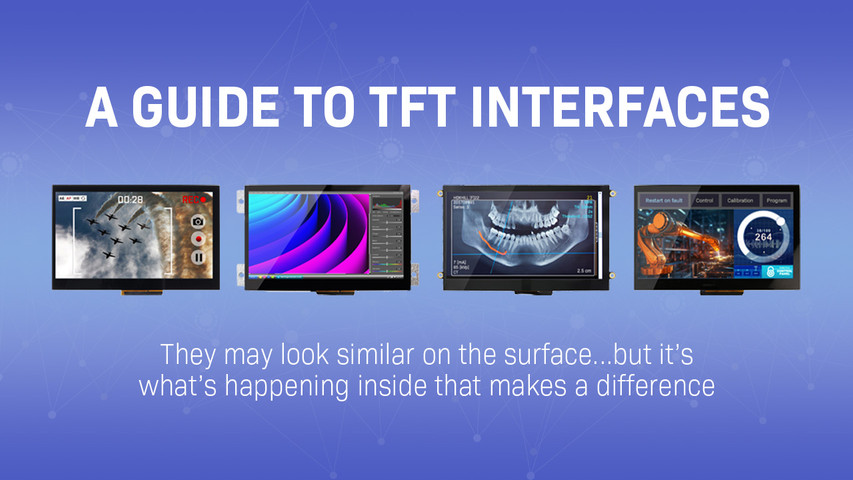Baud Rate
You have probably come across terms such as baud rate or bit rate when working with digital data communications. These two terms can be found on nearly every product datasheet as they are important in determining the efficiency and performance of communication systems.
This article covers everything you need to know about baud rate, from its definition, the difference between baud rate and bit rate, how it is calculated, and its significance in modern communication.
Dans cet article :
What is Baud Rate?
Baud rate is a unit of measurement of the speed at which data is transmitted in a communications channel. Baud rate measures the number of times a signal changes its state (such as voltage level or pulses) per second in a communication channel and is usually expressed in signal changes per second, denoted as "baud" or "Bd."

Learn more: Everything you need to know about parity bit
Difference between baud rate and bit rate
Baud rate refers to the number of signal changes per second, while bit rate or bits per second (bps) refers to the number of bits transmitted per second.
In most digital systems using binary code, 1 Baud = 1 bps. In some cases, one signal change can represent more than one bit so that the bps can be higher than the baud rate. Always check the datasheet to verify the data communication configuration.
| Term | Description |
|---|---|
| Baud rate (bd) | Baud rate is the number of signal changes that can be sent or received in one second. |
| Bit rate or bits per second (bps) | Bit rate is the number of bits (0s or 1s) that can be sent or received in one second. |

How to Calculate Baud Rate
To calculate the baud rate, we need two pieces of information: the bit rate and the number of bits per unit data. The baud rate is then calculated using the following formula:
Baud Rate = Bit rate (bps) / Number of bits per unit data
For example, let's say you have a system with a data rate of 2400 bits per second (bps) using a modulation technique, with each signal carrying two bits of information. In this scenario, the baud rate is computed as 2400 bps divided by 2, which equals 1200 baud.
Both the sender and receiver need to have the same baud rate settings in order to effectively send and receive data. Faster baud rates may increase the chance of errors due to noise or signal degradation, especially over long distances or poor quality connections.
Standard values such as 2400, 4800, 9600, 14400, and 19200 baud values have been widely adopted across various communication devices and systems to ensure compatibility and efficient data exchange.
The default baud rate for most Newhaven displays with RS232 interface is 9600, which is the same as the bit rate. This means that the display can receive and transmit data at a rate of 9600 bits per second by default.
If you need to change the baud rate for your Newhaven display, you can do so by using the display's command set. The specific instructions for changing the baud rate will vary depending on the model of display you have.
Learn more: Serial data communication standard RS232
Importance of Baud Rate in Communication Systems
- Communication Efficiency: Higher baud rates lead to faster data transmission, which enables efficient communication between devices.
- Bandwidth Utilization: Baud rate determines the bandwidth required for data transmission. A higher baud rate will demand more bandwidth, while a lower baud rate may lead to underutilization of the available bandwidth.
- Error Detection and Correction: As the baud rate increases, so does the possibility of errors in data transmission. Therefore, striking a balance between speed and accuracy is essential, and advanced error detection and correction mechanisms are used to maintain data integrity.
- Compatibility: In a communication system, it is important that all devices operate at the same baud rate to ensure smooth data transmission. Mismatched baud rates can result in communication failure, data loss, or corruption.
Baud Rate in Modern Communication Systems
Modern communication systems such as Wifi routers, mobile phones, and Bluetooth devices employ various modulation schemes that allow multiple bits to be transmitted per data units, making it possible to achieve high data rates without increasing the baud rate. Quadrature Amplitude Modulation (QAM) and Orthogonal Frequency Division Multiplexing (OFDM) are examples of such advanced modulation techniques.
These modern schemes contribute to higher spectral efficiency, which is a measure of how effectively the available bandwidth is utilized. This increased efficiency enables faster data transmission, higher data rates, and better overall performance in modern communication systems.
Conclusion
Baud rate remains a very important factor in digital communication, determining the speed of data transmission. While an increased baud rate can improve communication speed, it must be balanced with potential errors and channel limitations. As we progress in areas like quantum computing, understanding and optimizing the baud rate will continue to be crucial.
Derniers articles du blog
-
A Guide to TFT Display Interfaces
Display interfaces often get less attention than screen resolution or brightness, but they carry jus …Dec 16th 2025 -
Choosing the Right Display Resolution: A User-Friendly Guide
Display resolution is one of the most defining choices in product interface design. It determines ho …Dec 11th 2025 -
Arduino vs Raspberry Pi vs BeagleBone: Key Features and Differences
If you're working on an electronics project—whether it's for a DIY automated device, a digital sign, …Dec 8th 2025





